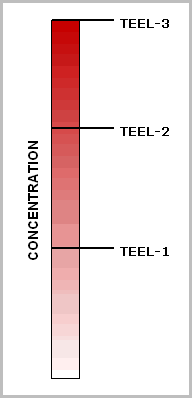Temporary Emergency Exposure Limits (TEELs)
TEELs are guidelines designed to predict the response of members of the general public to different concentrations of a chemical during an emergency response incident.
Note: TEEL values are no longer included specifically in ALOHA, see PACs.
What are TEELs?

TEELs estimate the concentrations at which most people will begin to experience health effects if they are exposed to a hazardous airborne chemical for a given duration. TEELs are used in similar situations as the 60-minute AEGLs and ERPGs.
A chemical may have up to three TEEL values, each of which corresponds to a specific tier of health effects. The three TEEL tiers are defined as follows:
- TEEL-3 is the airborne concentration (expressed as ppm [parts per million] or mg/m3 [milligrams per cubic meter]) of a substance above which it is predicted that the general population, including susceptible individuals, when exposed for more than one hour, could experience life-threatening adverse health effects or death.
- TEEL-2 is the airborne concentration (expressed as ppm or mg/m3) of a substance above which it is predicted that the general population, including susceptible individuals, when exposed for more than one hour, could experience irreversible or other serious, long-lasting, adverse health effects or an impaired ability to escape.
- TEEL-1 is the airborne concentration (expressed as ppm or mg/m3) of a substance above which it is predicted that the general population, including susceptible individuals, when exposed for more than one hour, could experience notable discomfort, irritation, or certain asymptomatic, nonsensory effects. However, these effects are not disabling and are transient and reversible upon cessation of exposure.
How are TEELs chosen?
TEELs are derived by the U.S. Department of Energy Subcommittee on Consequence Assessment and Protective Actions (SCAPA) according to a specific, standard methodology. The TEEL methodology uses available levels of concern and manipulates current data using a peer-reviewed, approved procedure in order to establish the TEELs.
AEGLs and ERPGs, on the other hand, are derived from extensive reviews of animal and human studies. Recognizing that AEGLs and ERPGs are better public exposure guidelines, the TEEL methodology prescribes replacing the TEEL value with those values when they become available. The 60-minute AEGL value is used preferentially, followed by the ERPG value.
Note: This hierarchy of values (60-minute AEGLs > ERPGs >TEELs) is implemented in the PACs dataset, which is provided by the TEEL developers.
However, the extensive review process for AEGLs and ERPGs that enhances the quality of those values also increases the amount of time it takes for chemicals to be defined under each system. Only about 175 substances have final AEGLs and about 150 chemicals have ERPGs.
TEELs can be derived relatively quickly for almost any chemical; as a result, TEELs are available for thousands of chemicals. TEELs can provide a useful reference when no other public exposure guidelines are available. To find out more about TEELs (or PACS), go to the TEELs and PACs Program website.
What substances have TEELs?
More than 3,000 chemicals have TEELs. To find current TEEL values, go to the PACs Database Search.
How should TEELs be used?
TEELs should be used to help protect the public when AEGLs or ERPGs are not available and there has been a chemical release that is short-term in duration. TEELs estimate how nearly all of the public would react to a release of this nature, so they can be used to identify areas where a hazard exists if the concentration of hazardous gas is exceeded for a given duration. For example, in areas with concentrations just above the TEEL-1, most people would experience temporary, non-disabling effects. On the other hand, in areas with concentrations just above the TEEL-2, most people would experience significant—but not life-threatening—health effects.
TEELs shouldn't be used as:
- Guidelines for workers who are routinely exposed to chemicals for longer durations. In such cases, you should use workplace exposure limits, because they contain safety factors specific to that type of exposure.
- Guidelines for members of the public who are exposed to background chemical releases for longer durations. In these types of air quality issues, values such as the National Ambient Air Quality Standards (NAAQS) should be used rather than emergency response guidelines.
TEEL Information Online
- PAC/TEEL Program Website: Get a summary of the PACs dataset and links to key resources on this Department of Energy site.
- PACs Database Search: Search for TEEL values in a database on this Department of Energy site. AEGL and ERPG values are also available.
- PACs/TEELs Program Background: Get background information on the PACs and TEELs development on this Department of Energy site.
